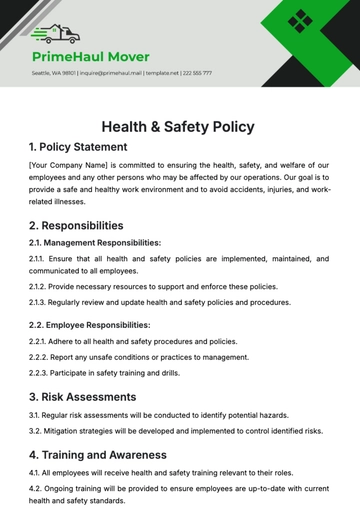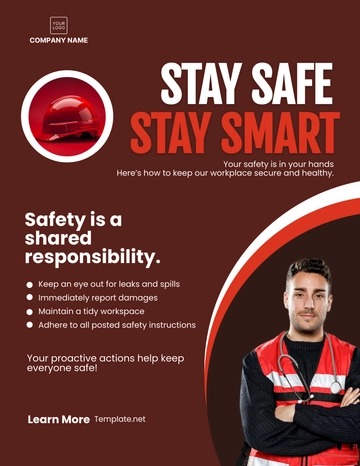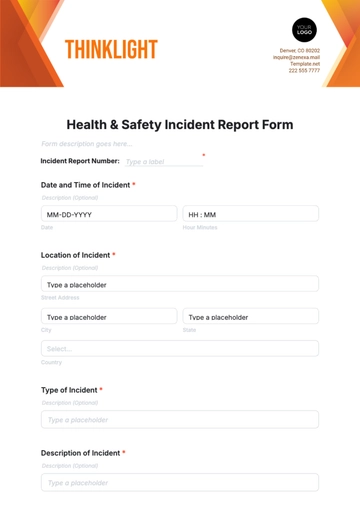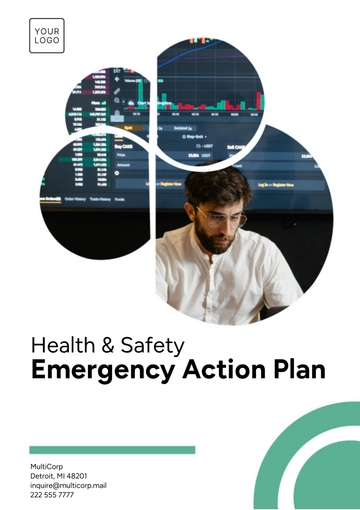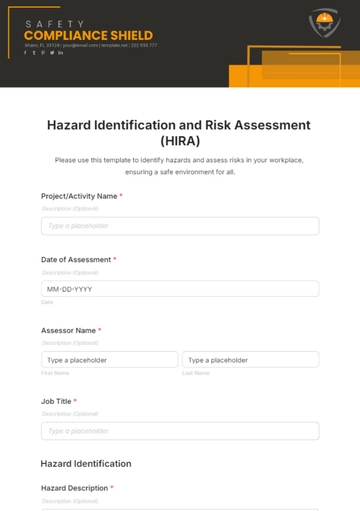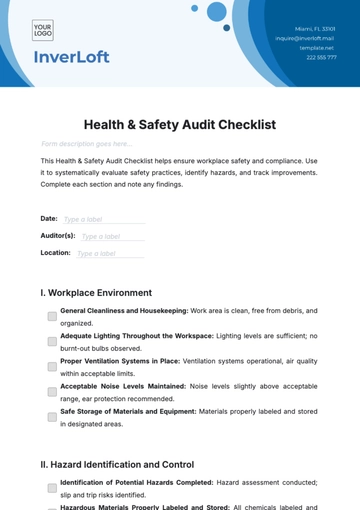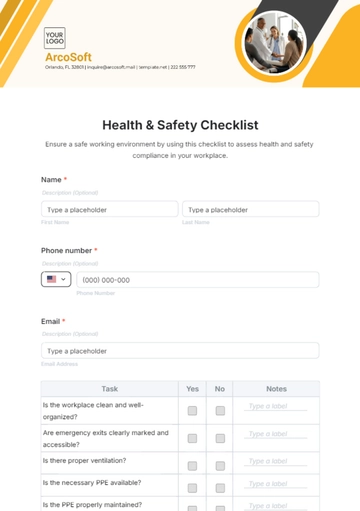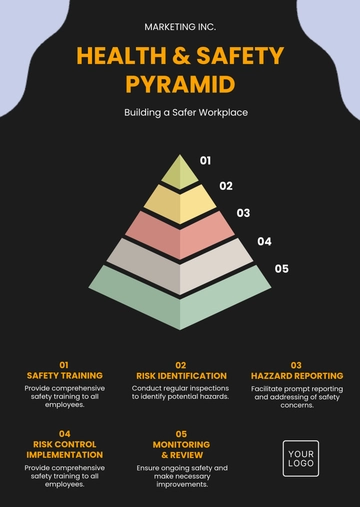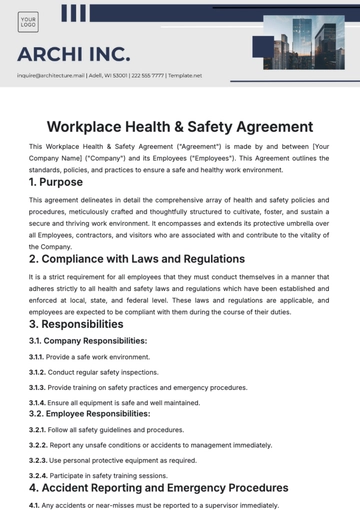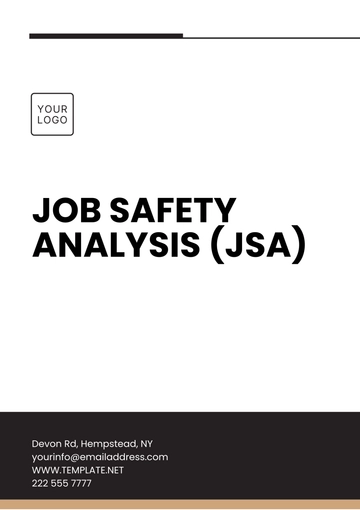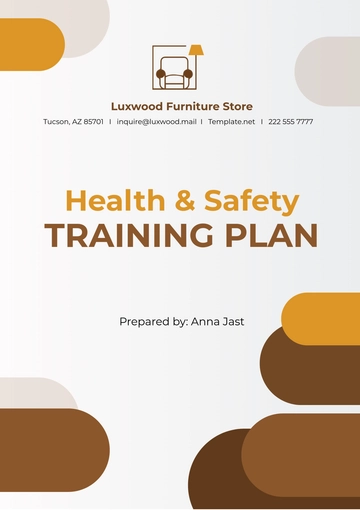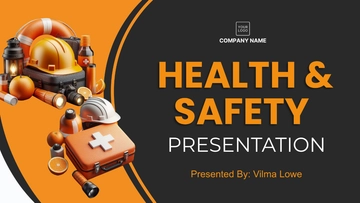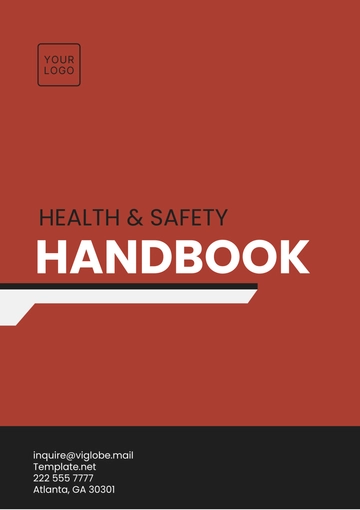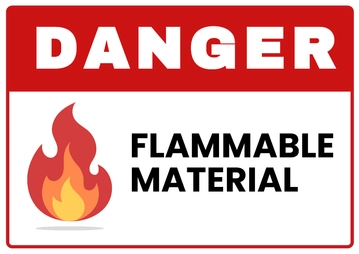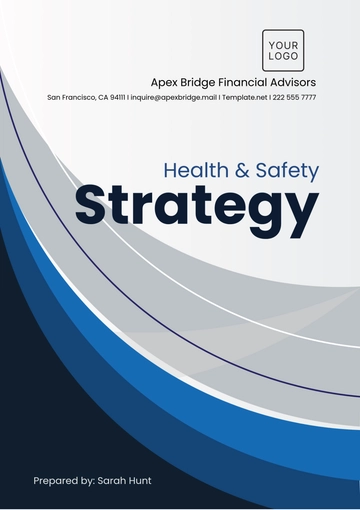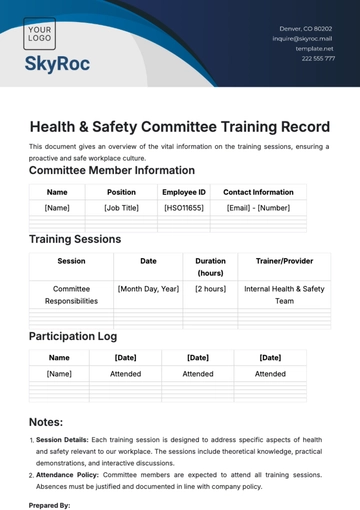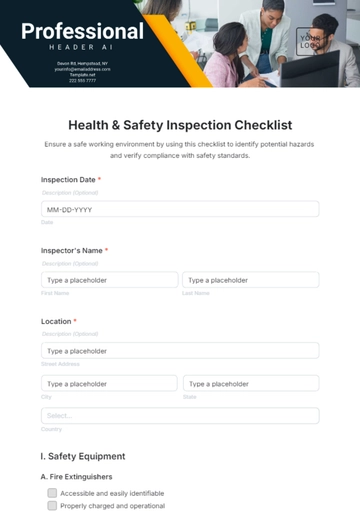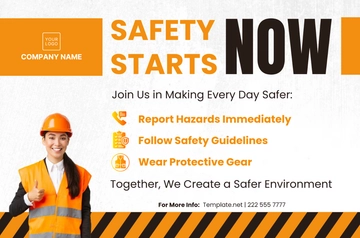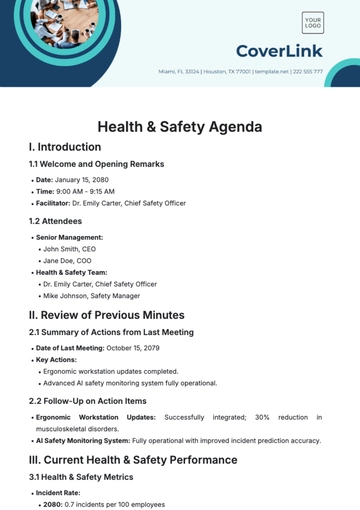Free Health & Safety Committee SOP
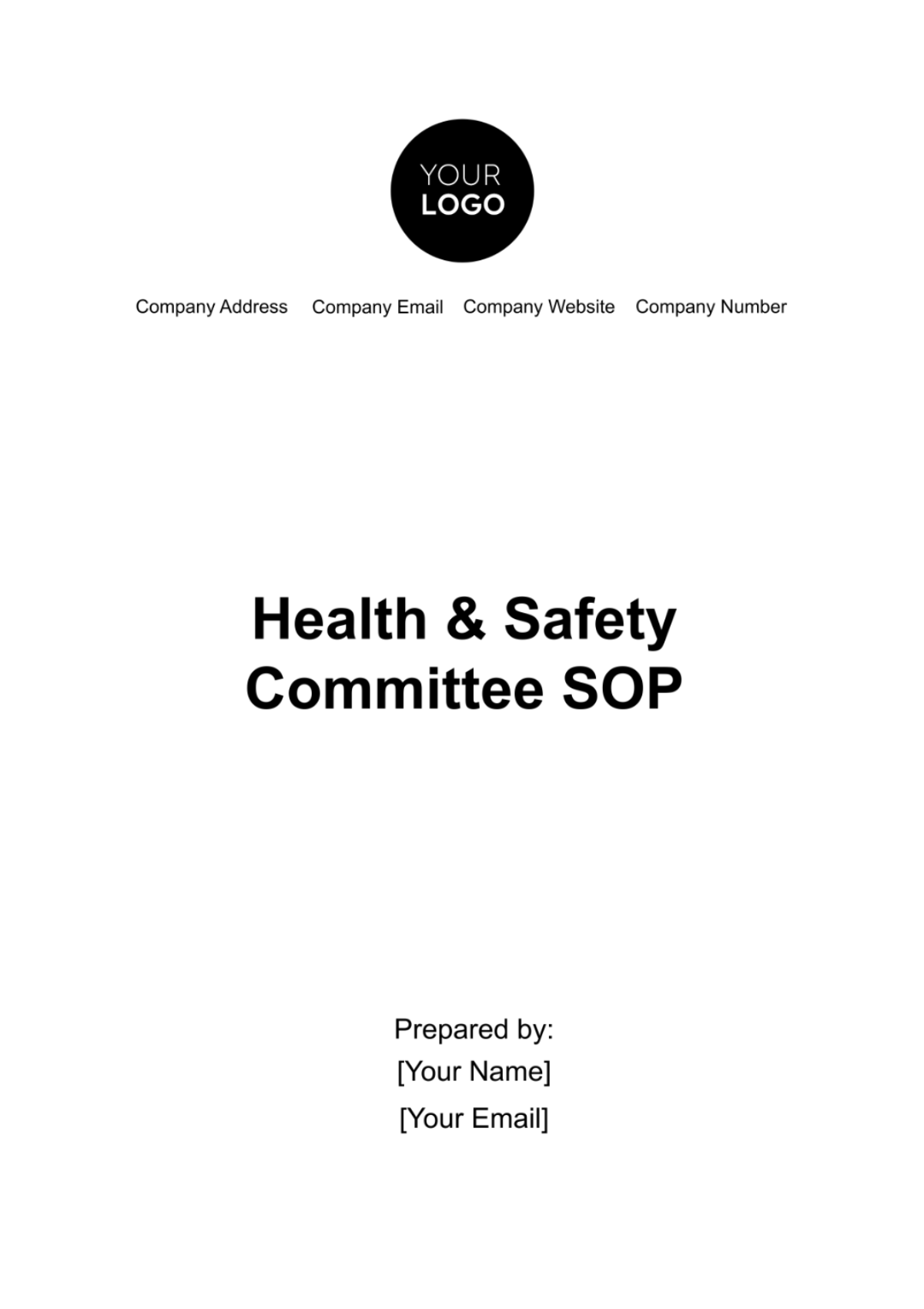
I. Purpose and Objectives of the Committee
The Health & Safety Committee at [Your Company Name] is established to safeguard the well-being of all employees by identifying, evaluating, and mitigating workplace hazards.
Statement of Purpose: The Committee's purpose is to foster a safe working environment by proactively addressing health and safety issues, ensuring compliance with legal standards, and promoting a culture of safety awareness. |
Committee Objectives: Key objectives include conducting regular safety audits, developing and reviewing safety policies, providing recommendations for safety improvements, and engaging in ongoing safety education and training for employees. |
II. Committee Composition and Member Responsibilities
A structured committee composition ensures diverse representation and effective safety management.
A. Committee Structure
The committee consists of a Chairperson, Vice-Chair, Safety Officers, HR Representatives, and Employee Representatives from various departments.
Role in Committee | Description | Appointed by |
Chairperson | Leads the committee, sets agenda | Senior Management |
Vice-Chair | Assists Chair, leads in their absence | Committee Members |
Safety Officers | Provides technical safety expertise | Safety Department |
HR Representatives | Advises on HR-related safety matters | Human Resources Department |
Employee Representatives | Voices concerns and suggestions from employees across departments | Employee nomination and vote |
B. Member Responsibilities
Responsibilities include attending meetings, participating in safety audits, contributing to policy development, and disseminating safety information within their respective departments.
Role in Committee | Key Responsibilities |
Chairperson | Organize and facilitate meetings, report to senior management, oversee action item implementation |
Vice-Chair | Support Chair in responsibilities, lead sub-committees, ensure meeting efficiency |
Safety Officers | Conduct and lead safety audits, provide expertise in safety policy development, train committee members on technical aspects of safety |
HR Representatives | Liaise between the committee and HR department, address safety-related personnel issues, contribute to safety culture initiatives |
Employee Representatives | Represent employee safety concerns, participate in safety inspections, disseminate safety information within their departments |
III. Meeting Guidelines
Regular and structured meetings are essential for the efficient operation of the committee.
A. Meeting Frequency and Scheduling
The committee meets on the first [Tuesday of every month]. Additional meetings are scheduled as needed for urgent matters.
Meeting Type | Frequency | Scheduling Details |
Regular Committee Meetings | Monthly | First [Tuesday] of every month |
Emergency Meetings | As needed | Scheduled within [48 hours] of identifying an urgent matter |
Sub-Committee Meetings | As required | Determined by the specific needs of the sub-committee |
B. Agenda Development
Agenda items are solicited from all members [two weeks] before each meeting. The Chairperson finalizes and distributes the agenda one week before the meeting.
Stage in Agenda Development | Responsibility | Process |
Agenda Item Submission | All Members | Submit potential agenda items two weeks prior to the meeting |
Agenda Review and Prioritization | Chairperson | Review and prioritize submitted items one week before the meeting |
Final Agenda Distribution | Chairperson | Distribute the finalized agenda to all members three days before the meeting |
C. Record Keeping
Minutes are recorded during each meeting, capturing key discussions, decisions, and assigned action items. Minutes are distributed to all members and relevant stakeholders within three days post-meeting.
Aspect of Record Keeping | Detail | Procedure |
Minute Recording | During Meeting | Assigned member records minutes, capturing discussions and decisions |
Action Item Listing | Post-Meeting | Include a summary of action items and assigned responsibilities |
Distribution of Minutes | Within 3 Days | Distribute minutes to all committee members and relevant stakeholders |
Archiving | Post-Distribution | Store minutes in a central repository for future reference |
IV. Safety Program Development and Implementation
The committee plays a crucial role in developing and implementing safety programs.
A. Program Development
The committee oversees the development of comprehensive safety programs, including emergency response plans, ergonomic assessments, and health and wellness initiatives.
Safety Program | Description | Development Process |
Emergency Response Plans | Procedures for handling workplace emergencies | Developed with input from all departments, led by safety officers |
Ergonomic Assessments | Evaluating and improving workstation ergonomics | Conducted in collaboration with an external ergonomics consultant |
Health and Wellness Initiatives | Programs to promote overall employee well-being | Developed with HR, focusing on mental health, physical fitness, and nutrition |
B. Implementation Strategies
Strategies include a phased rollout of programs, training sessions for employees, and regular updates to the management team on implementation progress.
Safety Program | Implementation Strategy | Timeline & Monitoring |
Emergency Response Plans | Phased rollout, starting with high-risk areas | Full implementation within 6 months, monthly progress reviews |
Ergonomic Assessments | Assessments department by department | Completion over 12 months, quarterly status updates to management |
Health and Wellness Initiatives | Launch during Health & Safety Week, ongoing activities throughout the year | Regular employee feedback surveys, annual review of program impact |
V. Monitoring, Evaluation, and Reporting
Continuous monitoring and evaluation are key to the effectiveness of safety initiatives.
Monitoring Procedures: The committee conducts regular monitoring of safety program implementation, utilizing checklists and audit reports to assess compliance.
Evaluation Process: Annual evaluations are conducted to assess the effectiveness of safety programs and initiatives, using metrics such as incident rates and employee feedback.
Reporting Mechanisms: A comprehensive safety report is compiled and presented to senior management semi-annually, highlighting achievements, challenges, and recommendations for further safety enhancements.
VI. Communication and Employee Engagement
Maintaining open communication channels and actively engaging employees are key to fostering a strong safety culture.
Internal Communication Strategies
Safety Newsletters and Bulletins: Regular distribution of safety newsletters and bulletins to keep employees informed about safety matters and updates.
Safety Announcements and Reminders: Use internal communication platforms for regular safety announcements and reminders.
Employee Engagement Activities
Safety Training Workshops: Host interactive safety workshops and training sessions to educate employees about safety practices and encourage active participation.
Safety Suggestion Program: Implement a suggestion program where employees can contribute ideas for improving workplace safety, fostering a sense of ownership and involvement.
Feedback and Improvement Mechanism
Regular Safety Surveys: Conduct annual safety surveys to gather employee feedback on safety concerns and areas for improvement.
Implementing Suggestions and Feedback: Actively review and implement feasible safety suggestions from employees, and communicate back the actions taken to encourage continuous engagement.
VII. Policy Review and Legislative Compliance
This section ensures that the Health & Safety Committee remains up-to-date with legal requirements and that safety policies are regularly reviewed and updated.
Policy Review Process
Annual Review of Safety Policies: The committee undertakes an annual review of all safety policies to ensure they align with current best practices and workplace needs.
Updating Policies: Any changes or updates to policies are documented, approved by the committee, and then communicated to all employees.
Legislative Compliance
Staying Informed on Legislation: The committee stays informed of changes in health and safety legislation through subscriptions to regulatory updates and liaisons with legal advisors.
Ensuring Compliance: Regular assessments are conducted to ensure that all safety practices and policies are compliant with current health and safety laws.
Integration with Corporate Policies
Alignment with Corporate Goals: Safety policies are aligned with the broader corporate goals and values of [Your Company Name].
Cross-Departmental Collaboration: Collaborate with other departments, such as Legal and HR, to ensure a holistic approach to policy development and compliance.
© [Year] [Your Company Name]. All Rights Reserved.
- 100% Customizable, free editor
- Access 1 Million+ Templates, photo’s & graphics
- Download or share as a template
- Click and replace photos, graphics, text, backgrounds
- Resize, crop, AI write & more
- Access advanced editor
Elevate your workplace safety standards effortlessly with Template.net's Health & Safety Committee SOP Template. Crafted to be fully editable and customizable using our Ai Editor Tool, this template streamlines the creation of robust SOPs. Safeguard your employees and operations with ease, thanks to Template.net's innovative solutions.

